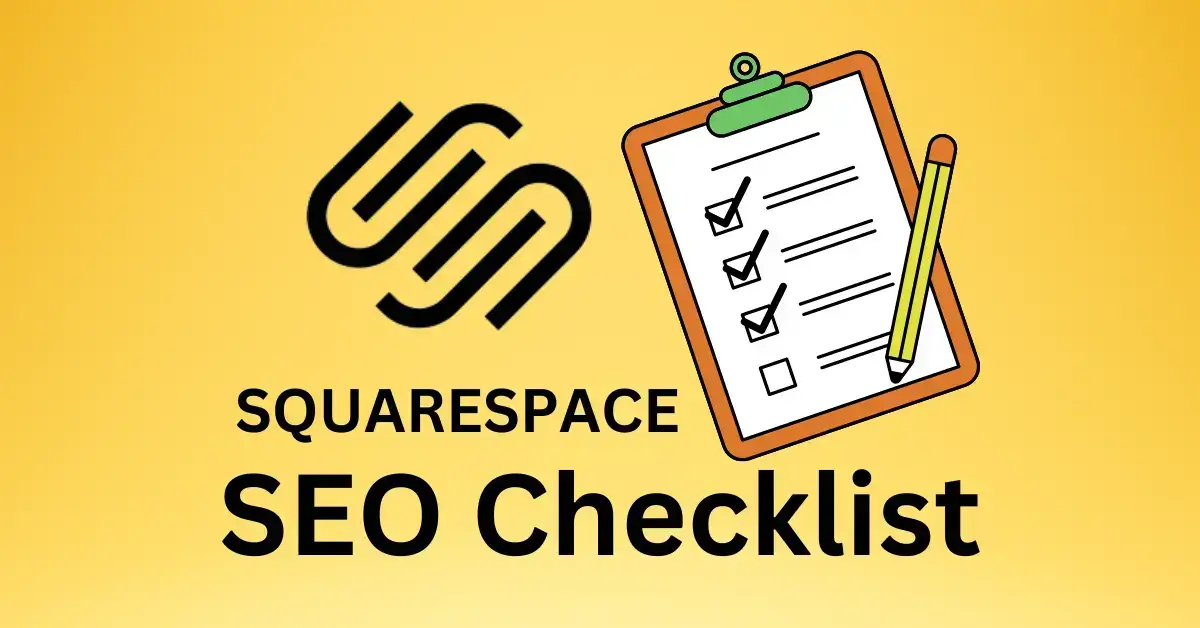Search engine optimization (SEO) is an essential part of any website’s success. With the help of SEO, websites are more likely to be found on search engine results pages (SERPs) and get more visitors. Squarespace is a popular platform for creating websites and blogs, but it can be difficult to know where to start when it comes to optimizing a Squarespace site for SEO. That’s why we’ve created the Squarespace SEO Checklist.
The purpose of the Squarespace SEO Checklist is to make it easier for Squarespace users to optimize their websites for SEO. It includes a list of key steps to take to ensure that your Squarespace site is properly optimized for search engines. You can make sure that your website is seen by the right audience and that it’s ranking as highly as possible in the search engine results.
You won’t have to search through endless pages of Google search results trying to figure out what you need to do to optimize your Squarespace site for SEO. You can quickly and easily complete to ensure that your site is optimized for SEO.
It provides a clear outline of tasks that you need to do and when they need to be done. This make sure that you’re on track with your SEO efforts.
By taking the time to follow the steps in the checklist, you can be sure that your website is seen by the right people and that it’s getting the attention it deserves. So lets check out this list
1. Site Settings:
a. Page Titles:
Page Titles are the title of each page of your website, and should accurately and concisely describe what the page is about. This helps search engines understand the content and context of your website, and can improve your SEO rankings.
b. Descriptions:
Descriptions are short snippets of text that appear on search engine results pages, and should accurately describe the content of each page on your website. Using relevant keywords in the descriptions can help improve your SEO rankings.
c. Permalinks:
Permalinks are the permanent URLs that are assigned to each page of your website. They should be short, descriptive, and should accurately reflect the content of the page.
d. SSL Certificate:
SSL certificates are the industry standard for securing data transmitted over the internet. Having an SSL certificate on your website can help improve your SEO rankings and provide a sense of security to your visitors.
e. Robots.txt:
Robots.txt is a file that tells search engine robots which pages of your website to index, and which pages to ignore. Properly configuring your robots.txt can help improve your website’s SEO rankings.
2. On-Page Optimization:
On-Page Optimization is an important part of optimizing your website for search engines. This Squarespace SEO Checklist focuses on four key elements: Headings and Subheadings, Alt Tags, Internal Links, and Image Optimization.
A. Headings and Subheadings:
Headings and Subheadings help to structure your content and provide search engine crawlers with information about your content. Using descriptive, keyword-rich headings and subheadings can help boost your ranking in search engine results.
B. Alt Tags:
Alt Tags are a type of HTML code used to define an image on the webpage. Adding keyword-rich Alt Tags to images can help search engine crawlers understand the content of your page and improve your website’s ranking.
C. Internal Links:
Internal Links are links that direct users to other pages within the same website. Adding strategic internal links can help boost page views, improve user experience, and boost your website’s search engine ranking.
D. Image Optimization:
Image Optimization is the process of compressing images to reduce their file size without compromising the quality of the image. This helps to improve page loading speed, which is an important factor in SEO rankings.
E.Content Optimization:
Content Optimization is a key part of making sure your website is optimized for search engine optimization (SEO). The Squarespace SEO Checklist focuses on three main areas of content optimization: Content Quality, Keyword Research, and Content-Length.
3. Offpage SEO
A. Link Building:
Link building is an important part of any SEO strategy and Squarespace offers great options for improving your site’s visibility. By creating content, submitting to directories, engaging on social media, and partnering with other websites, you can build high-quality links to your Squarespace site.
B. Guest Posting:
Guest posting is one of the most popular link building tactics. This involves writing articles and blog posts for other websites and including a link to your Squarespace website in the post. This can be a great way to get high-quality, relevant links to your website.
C. Link Exchange:
Link exchange is another form of link building. This involves finding websites in a similar niche to yours and exchanging links. This can be a great way to get links from high-quality sites and can help to boost your rankings in the search engines.
D. Directory Submissions:
Directory submissions are a great way to get backlinks to your Squarespace website. This involves submitting your website to directories and other listing services. These directories are then crawled by the search engine bots, which can help to improve your website’s ranking in the search results.
E. Forum Posting:
Forum posting is another form of link building. This involves participating in forums and other online communities and leaving a link to your website in your signature or in relevant posts. This can be a great way to get relevant, high-quality links to your website.
F. Online Reputation Management:
The success of any business depends on its reputation, and that’s why reputation management is essential. With the rise of digital marketing, online reputation management is becoming increasingly important for businesses. Squarespace offers a variety of tools and strategies to help businesses manage their online reputation and grow their brand.
F.1 Monitor Brand Mentions:
The first step to successful reputation management is to monitor brand mentions. Squarespace offers tools to help businesses monitor their brand’s presence across the web, including social media, forums, and search engines. By monitoring brand mentions, businesses can identify any potential issues and address them promptly.
F.2 Respond to Reviews:
The second step is to respond to reviews. Squarespace provides tools to help businesses monitor customer reviews and respond to them in a timely manner. Businesses can respond to both positive and negative reviews to show customers they care and value their feedback.
F.3 Address Negative Reviews:
The last step is to address negative reviews. Negative reviews can have a negative impact on a business’s reputation, so it’s important to address them promptly and professionally. Squarespace provides tools for businesses to respond to negative reviews, as well as strategies for resolving customer issues.
G. Content Promotion:
Here are three off-page SEO techniques you can use to promote your Squarespace website and increase your online visibility.
G1. Submit Content to Relevant Directories:
Submitting your website’s content to relevant directories can help you gain valuable backlinks and increase your website’s visibility in search engine results. You can submit your content to directories like Dmoz, Best of the Web, and Yahoo Directory.
G.2. Leverage Influencers:
Influencers are people with a large following on social media, and they can be a great way to drive more traffic to your site. Reach out to influencers in your niche and ask them to share your content. This will increase visibility for your website and attract more potential customers.
G.3. Leverage Social Networks:
Social networks like Facebook, Twitter, and Instagram can be effective tools for promoting your Squarespace website. Post regularly and use hashtags to increase visibility. You can also use Facebook Ads and Twitter Ads to target specific audiences and get more eyes on your content.
Finally The Squarespace SEO Checklist is an invaluable for any website owner looking to ensure their content is as optimized and visible as possible. By following the steps outlined in the checklist, website owners can ensure they are using the best SEO practices to maximize their website’s potential and attract more visitors. By utilizing the SEO Checklist, website owners can ensure their website has the best chance at success in the search engine rankings


